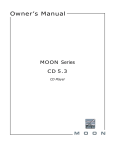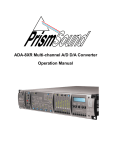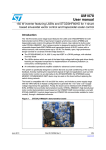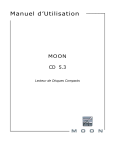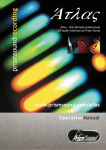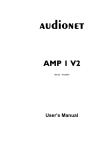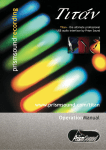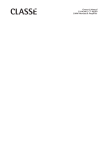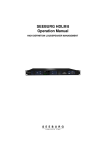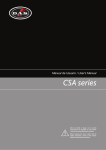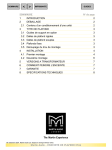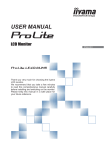Download prismsound DA-2 - Test and Measurement
Transcript
Professional D/A converter Operation Manual Issue 1.0 25 August 1998 Prism Media Products Limited Operation Manual Dream CONTENTS 1. INTRODUCTION . . . . . . . . . . . . . . . . . . . . . . . . . . . . . . . . . . . . . . . . . . . . . . 4 2. SUMMARY OF DA-2 FEATURES . . . . . . . . . . . . . . . . . . . . . . . . . . . . . . . . . 4 3. GETTING STARTED . . . . . . . . . . . . . . . . . . . . . . . . . . . . . . . . . . . . . . . . . . . 3.1. Unpacking your DA-2 . . . . . . . . . . . . . . . . . . . . . . . . . . . . . . . . . . . . . 3.2. Using the DA-2 for the first time . . . . . . . . . . . . . . . . . . . . . . . . . . . . . 3.3. DA-2 product concept and capabilities . . . . . . . . . . . . . . . . . . . . . . . . 3.4. Dynamic Range Enhancement (DRE) . . . . . . . . . . . . . . . . . . . . . . . . . 4. OPERATION . . . . . . . . . . . . . . . . . . . . . . . . . . . . . . . . . . . . . . . . . . . . . . . . . 8 4.1. Normal mode controls . . . . . . . . . . . . . . . . . . . . . . . . . . . . . . . . . . . . . 8 4.2. Set Inputs mode . . . . . . . . . . . . . . . . . . . . . . . . . . . . . . . . . . . . . . . . . 9 4.3. Set Level mode . . . . . . . . . . . . . . . . . . . . . . . . . . . . . . . . . . . . . . . . . 11 4.4. Set Master mode . . . . . . . . . . . . . . . . . . . . . . . . . . . . . . . . . . . . . . . . 12 5. FRONT-PANEL INDICATORS . . . . . . . . . . . . . . . . . . . . . . . . . . . . . . . . . . 5.1. Input selection or maximum output level setting indicators . . . . . . . . 5.2. 32kHz, 44.1kHz and 48kHz indicators . . . . . . . . . . . . . . . . . . . . . . . 5.3. `X2' indicator . . . . . . . . . . . . . . . . . . . . . . . . . . . . . . . . . . . . . . . . . . . 5.4. `Master' indicator . . . . . . . . . . . . . . . . . . . . . . . . . . . . . . . . . . . . . . . . 13 13 13 14 14 6. CONNECTORS . . . . . . . . . . . . . . . . . . . . . . . . . . . . . . . . . . . . . . . . . . . . . . 6.1. Analogue output connectors . . . . . . . . . . . . . . . . . . . . . . . . . . . . . . . 6.2. Interconnect screens - the pin 1 conditions . . . . . . . . . . . . . . . . . . . . 6.3. Connector table . . . . . . . . . . . . . . . . . . . . . . . . . . . . . . . . . . . . . . . . . 15 15 15 16 7. SPECIFICATION . . . . . . . . . . . . . . . . . . . . . . . . . . . . . . . . . . . . . . . . . . . . . 7.1. Digital Inputs . . . . . . . . . . . . . . . . . . . . . . . . . . . . . . . . . . . . . . . . . . . 7.2. Synchronization . . . . . . . . . . . . . . . . . . . . . . . . . . . . . . . . . . . . . . . . . 7.3. Digital Outputs . . . . . . . . . . . . . . . . . . . . . . . . . . . . . . . . . . . . . . . . . . 7.4. Analogue Outputs . . . . . . . . . . . . . . . . . . . . . . . . . . . . . . . . . . . . . . . 7.5. Performance Specification . . . . . . . . . . . . . . . . . . . . . . . . . . . . . . . . 7.6. Power . . . . . . . . . . . . . . . . . . . . . . . . . . . . . . . . . . . . . . . . . . . . . . . . 7.7. Physical Dimensions . . . . . . . . . . . . . . . . . . . . . . . . . . . . . . . . . . . . . 17 17 20 21 24 25 27 27 8. INTERNAL CONFIGURATION OPTIONS AND FUSES . . . . . . . . . . . . . . . 8.1. Fuses . . . . . . . . . . . . . . . . . . . . . . . . . . . . . . . . . . . . . . . . . . . . . . . . 8.2. PCB jumper links . . . . . . . . . . . . . . . . . . . . . . . . . . . . . . . . . . . . . . . . 8.3. Mains transformer voltage selection . . . . . . . . . . . . . . . . . . . . . . . . . 28 28 28 29 Issue 1.0 25 August 1998 5 5 5 7 7 © Prism Media Products Limited Page 2 of 30 Prism Media Products Limited Operation Manual Dream 9. ELECTROMAGNETIC COMPATIBILITY . . . . . . . . . . . . . . . . . . . . . . . . . . . 29 10. REFERENCES . . . . . . . . . . . . . . . . . . . . . . . . . . . . . . . . . . . . . . . . . . . . . . 30 Manual Revision History 25 August 1998 Issue : 1.0 ; Original Issue Product Revision History August 1998 Hardware revision A Prism Media Products Limited William James House Cowley Road Cambridge CB4 4WX UK Phone: +44-(0)1223-424988 Fax: +44-(0)1223-425023 Email: [email protected] Web: http://www.prismsound.com Issue 1.0 25 August 1998 © Prism Media Products Limited Page 3 of 30 Prism Media Products Limited Operation Manual 1. Dream INTRODUCTION The Dream is a 24-bit, 96kHz-capable digital-to-analogue converter intended for professional audio use in applications where a very high performance is required; for monitoring, for example in the production of high quality masters, or for conditions such as live recording where a large headroom may be required. The Prism Sound Dynamic Range Enhancement (DRE) system is also incorporated for use in monitoring and/or decoding a DRE encoded source. 2. SUMMARY OF DA-2 FEATURES • • • • • • • 24-bit input resolution Sampling rates to 96kHz 114 dB A-weighted dynamic range Less than -104 dB THD+N at full scale (0.0006%) Flat low frequency response (-0.05 dB at 5.0 Hz) Floating balanced outputs Calibrated maximum output level adjustment: +5 dBu to +28 dBu in 1 dB steps Fine trim in steps of 0.05dB DRE decoding to analogue and digital outputs Input selection from seven stereo inputs Digital inputs in AES3, AES3 'Split96', SPDIF, Optical, AES-3ID coax, and SDIF-2 formats Digital outputs in AES3, SPDIF, Optical, and SDIF-2 formats simultaneously; also AES3 'Split96' capability Digital interface format conversion Mute control on front panel Invert control on front panel De-emphasis of emphasised signals (Both CD and J17 characteristics) Low jitter, high precision clock with: Capture range better than IEC958 specification (±1500ppm) Excellent jitter tolerance ( >200ns at 2kHz) Excellent jitter rejection (-60dB at 500Hz) Clock master mode • • • • • • • • • • Issue 1.0 25 August 1998 © Prism Media Products Limited Page 4 of 30 Prism Media Products Limited Operation Manual 3. Dream GETTING STARTED It is not necessary to read all the manual before being able to use the Dream . This section contains all the information required for you to get going straight away. 3.1. Unpacking your DA-2 Check that you have the following items and that they are undamaged: " " " Dream converter unit Dream operation manual (this book) IEC320 type mains lead with appropriate plug for your supply Check that your unit carries a label on the rear panel indicating the correct mains voltage for your application area and that the plug fitted to the mains lead is of the correct type. If not, DO NOT CONNECT THE MAINS SUPPLY, but contact your distributor. Please keep the packaging for re-use in the event that the unit should be shipped to another location or in the event that it should ever need to be returned to the manufacturer for repair or upgrade. 3.2. Using the DA-2 for the first time Connect a digital audio source to one of the inputs on the DA-2. 3.2.1. AES or SPDIF sources Source equipment operating at any of the standard rates from 32kHz to 96kHz may be connected to any of the inputs including the BNC connectors. 3.2.2. Higher sampling-rate sources using “Split96" or “2-wire” format For Split96 (2-wire) sources you must use inputs 2 and 3 in the DA-2 “Split96" mode as only these inputs can handle this format. Input 2 will be routed to the left output channel and Input 3 will be routed to the right channel. 3.2.3. SDIF-2 format If the source is in the Sony Digital Interface Format (SDIF-2) then the three BNC inputs, labelled L, R and WCK need to be used. [The L & R inputs are dual function and autosensing, so SDIF-2, AES3-ID and SPDIF signals can be connected.] Note: For more information about configuration of DA-2 inputs, refer to section 4.2. Issue 1.0 25 August 1998 © Prism Media Products Limited Page 5 of 30 Prism Media Products Limited Operation Manual 3.2.4. Dream Output connector wiring The analogue outputs of the DA-2 are wired as follows: pin 1 Screen and mid-point of balanced output pin 2 Balanced output (Hot or `+') pin 3 Balanced output (Cold or `-') Conventional connections to a balanced analogue input should use a screened twisted pair lead. The DA-2 output pins 2 and 3 should be wired to the two conductors of the pair and pin 1 to the cable screen. The other end of the cable should be connected in a similar manner. 3.2.5. Connecting the DA-2 to unbalanced inputs For optimum performance the DA-2 should be connected to an unbalanced input using only pins 1 and 2. Pin 2 should connect to the signal conductor and pin 1 should connect to the ground or return. The signal level is then halved. NOTE : Use of output pin 3 instead of 2 will result in phase inversion. [It is possible to drive unbalanced inputs from pins 2 and 3 but this unbalances the output and can lead to hum. In any case do not connect any of the three output pins to each other]. 3.2.6. Powering up for the first time Connect the mains supply and switch on the DA-2 unit. The front-panel LEDs should all illuminate momentarily; if any of them fails to light it may be faulty. If so then check again by turning the unit off and on. If the problem is still evident contact your distributor. After the unit has initialised one of the seven input selection lights on the left of the front panel will illuminate to indicate the selected input. This indicator will be steadily on if the signal at the selected input is being decoded without error. It will flash if a signal is not detected, and briefly extinguish when individual errors are detected. To select a different input press the round select push-button on the left hand side of the front panel. When you have selected the input you require then, if the signal is decoded correctly and the unit is configured to the factory default settings, then only the appropriate sample rate indicator and the input selection indicator will be steadily on. This indicates that the unit is now operating correctly. If the output level needs adjustment refer to section 4.3. NOTE: If you are having problems with any of these controls it may be because the configuration has been altered from the factory defaults. If you wish to return all the DA-2 settings to the factory defaults then switch the unit on Issue 1.0 25 August 1998 © Prism Media Products Limited Page 6 of 30 Prism Media Products Limited Operation Manual Dream while pressing all four of the right hand buttons during the whole of the start-up cycle - this takes approximately ten seconds. In the default configuration the indicators for the four right hand side controls should not be on. If the set button indicator is on then press the button to leave `set' mode. If any of the other control button indicators are on then press the respective control buttons to toggle them off. If you are still having problems setting the unit into the standard configuration described above, then refer to the descriptions of the set inputs (section 4.2), or set master (section 4.4) controls. 3.3. DA-2 product concept and capabilities The Dream is designed to provide a very high quality of digital-to-analogue conversion without sampling jitter or data truncation - whatever the resolution or timing accuracy of the source. Two other useful features are also provided. These are a set of jitter-filtered digital outputs and a Dynamic Range Enhancement (DRE) decoder. The digital outputs normally provide the same data as present on the selected digital input, translated into the appropriate format, and any incoming jitter is filtered off. This means that the Dream is also a digital audio format converter, corrector and jitter remover. 3.4. Dynamic Range Enhancement (DRE) DRE is a process designed for the increasing the dynamic range of 16-bit recording channels, such as DAT, CD-R, or 1630+U-matic, when further post-processing is required. It requires an encode process on recording and a decode process on playback. It is suitable for applications where 20-bit dynamic performance is desired of the recorder but only a 16-bit recorder is available, and where the requirement for a decode process is acceptable. The Prism Sound Dream AD-2 and AD-124 analogue-to-digital converters can encode DRE signals from digital or analogue sources, and can also decode them (in digital-to-digital mode) to transfer the high resolution signal, encoded on a 16-bit tape, onto a 20 bit digital audio workstation. The Dream can be used with the AD-2 or AD-124 to provide analogue monitoring of the encoded signal, as well as to perform the digital to digital decoding function required for transfers to the 'linear' or 'non-DRE' domain. Issue 1.0 25 August 1998 © Prism Media Products Limited Page 7 of 30 Prism Media Products Limited Operation Manual 4. Dream OPERATION There are five control buttons. In normal use they operate in isolation to Select the digital source, MUTE the output, INVert the output and turn on the DRE decode function. When setting up the unit, the configuration settings - which are intended to be set and then left alone - can be modified from one of the three 'set' modes: Set Inputs, Set Level and Set Master. The SET button is illuminated to indicate one of these modes. All the control settings are saved in permanent memory so that they are retained when the unit is off. 4.1. Normal mode controls The following functions apply to the MUTE, INV and DRE controls only if the SET control is off. This indicates normal mode and is the power on state. 4.1.1. MUTE This mutes the analogue output. Digital outputs are unaffected. 4.1.2. INV This inverts the polarity of both analogue outputs. Digital outputs are unaffected. 4.1.3. DRE This control is used to switch on the DRE decoding function on the digital input (DRE is described in section 3.4). Both the analogue and digital outputs are affected by this control. 4.1.4. Select (input) Pressing this button causes the selected digital input to switch to the next enabled input - see section 4.2. NOTE: If this control does not seem to operate correctly it may be because some inputs have been disabled. Refer to the description of the Set Inputs control, section 4.2, to change this. Issue 1.0 25 August 1998 © Prism Media Products Limited Page 8 of 30 Prism Media Products Limited Operation Manual 4.1.5. Dream SET Holding this button down while pressing one of the three adjacent switches puts the unit into one of the following control modes: Either Set Inputs, Set Level, or Set Master, as described by the red front-panel legends. These modes allow the user to modify the configuration of the DA-2. In normal use they are not required. 4.2. Set Inputs mode The Set Inputs mode is used to enable or disable the selection of individual digital inputs to avoid cycling through unused inputs when switching between sources. (Note: in this mode the MUTE button has the function of enabling the inputs. For that reason it is referred to as the MUTE/Inputs control.) To enter Set Inputs mode, the DA-2 must first be in normal mode (i.e. if the SET control is not already illuminated). While holding the SET button down, press the MUTE/Inputs button. This mode is indicated by both the MUTE/Inputs and the SET LEDs being lit. The seven input indicators on the left of the unit illuminate to indicate the inputs that are enabled. One (or two) of the indicators will be flickering to show the input(s) selected for enabling or disabling. Press the MUTE/Inputs control to toggle the enable state of this(these) input(s). The flickering will toggle between fast (mostly on), indicating enabled and slow (mostly off) indicating disabled. Press the Select button to cycle through the other inputs so that they can then be enabled or disabled using MUTE/Inputs. Inputs DI2 and DI3 (the second and third AES3 XLR inputs) can be configured as a 'Split96' input (see below). If configured for Split96 operation when selecting inputs for enabling or disabling, the indicators for DI2 and DI3 will operate together. 4.2.1. Split96 Sources Once in SET Inputs mode (see above), press the INV/Split96 button, to change the mode of inputs 2 and 3 for either Split96 (2-wire) or normal (1-wire) operation. Issue 1.0 25 August 1998 © Prism Media Products Limited Page 9 of 30 Prism Media Products Limited Operation Manual Dream In Split96 mode, two AES3 bearers both at 44.1kHz or 48kHz carry a stereo 88.2kHz- or 96kHz-sampled signal, with one channel carried on each bearer as described in ref. 8. “Split96" or “2-wire AES” sources may only be connected to Inputs 2 & 3. Split96 mode (for DI2 & DI3 only) is indicated once in Set Inputs mode by the INV/Split96 LED being ON. Thereafter, inputs DI2 and DI3 are treated as a Split96 pair unless the INV/Level (Split96) button is used again to separate them - this is irrespective of the mode expressed in the channel status. In Split96 mode input 2 carries the left channel and input 3 carries the right channel. Split96 mode is only available on inputs 2 & 3 and the Split96 indication does not change while in SET Inputs mode if other inputs are selected for enabling ro disabling. NOTE: When XLR inputs DI2 and DI3 are configured for Split96 operation, the digital XLR outputs, DO1 and DO2 are automatically set to provide Split96 output if the DA-2 is operating at 88.2kHz or 96kHz. Output channel status in this mode is in accordance with the proposed recommendations in ref. 8. Press SET to leave Set Inputs mode and return to normal mode. Issue 1.0 25 August 1998 © Prism Media Products Limited Page 10 of 30 Prism Media Products Limited Operation Manual 4.3. Dream Set Level mode Set Level mode sets the maximum analogue output level for a full-scale digital input. Range is from +5dBu to +28dBu in either 1dB steps or fine steps of 0.05dB. To enter Set Level mode, the DA-2 must first be in normal mode (i.e. if the SET control is not already illuminated). While holding the SET button down, press the INV/Level button. Set Level mode is indicated when both INV/Level and SET LEDs are lit. In this mode, the seven selector lights at the left hand side will show a pattern that relates to the output level. The text in red under the LEDs indicates the value of each LED. The maximum output level (in dBu) is calculated by adding the value of all the LEDs that are on. (Remember that when connecting to an unbalanced input as described in section 3.2.5, 7.4.1 the output level will be attenuated by 6dB.) 4.3.1. Setting the maximum output level To set the maximum output level, press the Select button repeatedly until the desired level is reached. Each press will raise the level by 1dB until +28dBu, beyond which the level will return to +5dBu. 4.3.2. Fine output level adjustment To make a fine level adjustment hold down the INV/Level control while pressing the Select button. Each time Select is pressed a level adjustment of -0.05dB is applied until 0.95dB, beyond which the trim returns to zero. The trim value is not displayed. If the trim is active, INV/Level will flash when in Set Level mode. The fine trim can be cleared by pressing the Select button once in Set Level mode. The INV/Level LED will then cease flashing and remain lit. Subsequent operations of Select will apply the normal +1dB gain step for setting the maximum output level. Note that the best dynamic range is achieved when one of the standard levels (+12, +18, +22, +28) is used and the other LEDs (-4, -2, -1) are not illuminated. The latter LEDs show the amount of digital attenuation that has been applied. As this attenuation lowers the maximum level but not the noise floor it reduces the dynamic range by that amount. For example, with a level setting of +13 dBu the analogue level is set to +18dBu with a digital attenuation of 5dBu. Therefore the dynamic range is reduced by 5dB compared with the +18dBu setting. Issue 1.0 25 August 1998 © Prism Media Products Limited Page 11 of 30 Prism Media Products Limited Operation Manual Dream Press SET to leave Set Level mode and return to normal mode. 4.4. Set Master mode Set Master mode is used to set the DA-2 to be clock master and change the sample rate it uses when master. As a clock master the DA-2 requires incoming data to be synchronized to the DA-2 internal clock. Any of the DA-2 digital outputs can be used as a synchronization reference to the source of the data. To enter Set Master mode, the DA-2 must first be in normal mode (i.e. if the SET control is not already illuminated). While holding the SET button down, press the DRE/Master button. This mode is indicated by both the DRE/Master and the SET LEDs being lit. 4.4.1. Setting master or slave synchronization In Set Master mode, pressing the DRE/Master button toggles between master (internal) and external synchronization. This is indicated by the amber Master light situated beneath the frequency lights at the left of the front panel. If this light is on then the DA-2 is synchronized to a precise free-running internal oscillator; otherwise it is synchronized externally. (If it is flashing then one of two error states is indicated as described in section 5.4). 4.4.2. Master mode sampling rate selection In Set Master mode, if the DA-2 is configured as a clock master then the sampling frequency can be changed by pressing the Select button. This action cycles between the available sample rates, which are displayed by the '32kHz', '44.1kHz' and '48kHz' LEDs, and also the 'X2' LED which is used to qualify 88.2kHz and 96kHz modes. If not configured as clock master then the Select button has no effect. NOTE : 64kHz sampling is not supported. Press SET to leave Set Master mode and return to normal mode. Issue 1.0 25 August 1998 © Prism Media Products Limited Page 12 of 30 Prism Media Products Limited Operation Manual 5. FRONT-PANEL INDICATORS 5.1. Input selection or maximum output level setting indicators Dream The horizontal bank of seven green LEDs on the left side of the front panel performs three functions: 5.1.1. Selected input indication In Normal mode (the SET control not illuminated) one of the LEDs will be illuminated to show the currently selected input. It will flash if that input is not present or is incorrect. On receipt of single errors it will briefly extinguish. In certain special modes, more than one indicator may be lit, as follows: C C Split96 (2-wire) mode for inputs 2 & 3 (see section 4.2.1 and section 7.1.2) SDIF-2 format using inputs 6 & 7 (see section 7.1.5) 5.1.2. Enabled inputs indication In Set Inputs mode (the SET and Inputs controls being illuminated) the LEDs corresponding to the enabled inputs will be illuminated. The LEDs corresponding to the disabled inputs will be off. One LED will be flashing to indicate the input that will be enabled or disabled if the Inputs control is pressed. (See section 4.2) 5.1.3. Peak output level indication In Set Level mode (the SET and Level controls being illuminated) the LEDs give an indication of the output level corresponding to peak code. This level, in dBu, is calculated from the sum of the illuminated LEDs. (When connecting to an unbalanced input as described in section 3.2.5, 7.4.1 the output level is 6dB less than this value.) For example: +20dBu is shown by only the +22 and -2 LEDs being illuminated; +28dBu is shown by only the +28 LED being illuminated. A typical consumer unbalanced level of 8dBu, which is equivalent to balanced 14dBu, needs to be indicated by the +18 and -4 LEDs being indicated. 5.2. 32kHz, 44.1kHz and 48kHz indicators If the operating sample rate is within the capture range of the high precision PLL then one of these indicators will indicate the sampling frequency (possibly in conjunction with the 'X2' indicator to show 88.2kHz or 96kHz operation as described in the following section). The appropriate indicator(s) will flash if the unit has lost the source of synchronization and defaulted to free-run from the internal clock. If externally synchronized at a non-standard rate, all indicators are off. Issue 1.0 25 August 1998 © Prism Media Products Limited Page 13 of 30 Prism Media Products Limited Operation Manual 5.3. Dream `X2' indicator This LED will illuminate if the unit is synchronized to a rate between 60 and 100kHz. When the ‘X2' indicator is lit, the D/A converter sampling-rate is double that of the normal lowerrate indicator. 5.4. `Master' indicator The Master indicator shows several different conditions: LED off: Sync OK - external synchronization selected with no errors LED flashing in time with one of the frequency indicators: No Sync - external synchronization selected but failed LED on: Clock master mode - either no input or the input is correctly synchronized to the DA-2 master LED mostly on but occasionally blinking off: Sample slipping in master mode - each blink corresponds with a missed or repeated audio sample Issue 1.0 25 August 1998 © Prism Media Products Limited Page 14 of 30 Prism Media Products Limited Operation Manual 6. CONNECTORS 6.1. Analogue output connectors Dream Conventional connections to a balanced analogue input should use a screened twisted pair lead. The DA-2 output pins 2 and 3 should be wired to the two conductors of the pair and pin 1 to the cable screen. The other end of the cable should be connected in a similar manner with the screen connecting to the chassis of the analogue input. The DA-2 should be connected to an unbalanced input using only pins 1 and 2 of the output XLR. Pin 2 should connect to the signal input and pin 1 should connect to the input ground. Using this method the signal level is half the nominal value. NOTE: It is possible to drive unbalanced inputs from pins 2 and 3 of the DA-2 analogue output but, because the connection has been unbalanced, this will give slightly worse performance. However, if the output is connected in that way, it is important that pin 1 is not connected at the unbalanced input end as this will short circuit one leg of the floating output driver. 6.2. Interconnect screens - the pin 1 conditions 'Screen' connects directly to the chassis for the digital XLR and BNC connectors. The RCA digital coaxial connections are transformer isolated with the screen coupled to the chassis using a capacitor at the connector. The analogue output screens are the mid points of the floating differential outputs. They are coupled to the chassis using a capacitor from pin 1 to the chassis. Issue 1.0 25 August 1998 © Prism Media Products Limited Page 15 of 30 Prism Media Products Limited Operation Manual 6.3. Dream Connector table Viewed from the rear the connectors are as follows: Left Hand Side IEC320 XLR-Male Analogue Analogue out left/A XLR-Male Outputs Analogue out right/B XLR-Female DI1 - AES3 XLR-Female DI2 - AES3 (Left channel for Split96, 2-wire 96kHz) XLR-Female DI3 - AES3 (Right channel for Split96, 2-wire 96kHz) OPTICAL Digital DI4 - IEC958 optical RCA-phono Inputs DI5 - IEC958 coaxial BNC-75S DI6 - AES-3ID or L - SDIF-2 input left/A BNC-75S DI7 - AES-31D or R - SDIF-2 input right/B BNC-75S WCK - Word-clock input BNC-75S L - SDIF-2 output left/A BNC-75S R - SDIF-2 output right/B BNC-75S RCA-phono Right Hand Side Mains power inlet Digital WCK - Word-clock output Outputs IEC958 consumer format OPTICAL IEC958 consumer format XLR-Male DO1 - AES3 output 1 XLR-Male DO2 - AES3 output 2 XLR wiring conventions for both analogue and digital connections are: pin 1 Screen pin 2 Balanced input or output (Hot or `+') pin 3 Balanced input or output (Cold or `-') Issue 1.0 25 August 1998 © Prism Media Products Limited Page 16 of 30 Prism Media Products Limited Operation Manual 7. Dream SPECIFICATION The following specification, offered in good faith, is subject to change without notice. Errors and omissions excepted. 7.1. Digital Inputs All inputs can handle sources with sampling rates from 32kHz to 96kHz. Some inputs have special functions such as inputs 2 & 3 (Split96 or 2-wire mode) and inputs 6 & 7 (AES3-ID or SDIF-2). 7.1.1. General (except SDIF-2) Jitter Tolerance Above 12kHz: 50Hz to 12kHz: Below 50Hz: 0.5UI (This is 88.6ns at fs = 44.1kHz) Increases with falling jitter frequency. e.g: 0.75 UI at 8kHz 30 UI at 200Hz > 128UI (22.7 us at fs = 44.1kHz) Note: Jitter tolerance is a measure of the ability of a receiver to correctly decode a digital interface signal which has jitter. Like most other jitter parameters it is normally measured in 'unit intervals'. A unit interval (UI) corresponds to the smallest nominal time interval in the interface signal, for the AES3 or IEC958 interface formats there are 128 unit intervals per sample. Therefore at a sample frequency of 44.1kHz the unit interval is 177 ns. References 5 and 6 explain interface jitter in more detail. Digital Input Resolution/Word-Length: 24 bits The Dream resolves all the data bits of the digital interface formats. Input signals are not truncated and hence truncation distortion does not occur. For example: a sine wave modulating only the lowest 4 bits of the 24-bit interface signal is reproduced at the correct amplitude. Note that, in conformance with the digital audio interface specifications, all signals with consumer channel status and a Category Code indicating a 16-bit or 20-bit device, and signals with professional channel status that indicate that the auxiliary audio data bits do not carry the main audio signal, will have the lower 4 bits masked off to avoid non-audio data adding to the audio. The SDIF-2 format is also limited to a maximum resolution of 20-bits for the audio data. 7.1.2. Balanced AES-3 XLR inputs: DI1, DI2, DI3 Input impedance: 110S. These conform with the professional interface, AES3-1992 [Ref. 1], with transformers for improved isolation. However if the data is encoded according to the consumer format of IEC958 [Ref. 4] it is also decoded correctly. Issue 1.0 25 August 1998 © Prism Media Products Limited Page 17 of 30 Prism Media Products Limited Operation Manual Dream Pin 1 of the XLR connector is connected to the chassis via a capacitor and the signal is presented differentially across pins 2 and 3. NOTE: XLR inputs 2 and 3 may be jointly configured as a 'Split96' input, allowing stereo 88.2kHz- and 96kHz-sampled inputs with one channel on each bearer. This format is described in ref. 8. 7.1.3. Optical input: DI4 This input is physically compatible with the Toshiba `TosLink' fibre-optic connector, and data encoded according to professional (AES3-1992) or consumer (IEC958) formats is correctly decoded. 7.1.4. Coaxial (RCA) consumer input: DI5 Input impedance: 75S. This conforms to the coaxial specification of IEC958 and, for improved isolation, has transformer isolation with the screen capacitatively coupled to the chassis. Data encoded according to professional (AES3-1992) or consumer (IEC958) formats is correctly decoded. 7.1.5. Dual-function coaxial (BNC) professional inputs: DI6, DI7 Input impedance: 75S. The connectors either operate as coaxial AES3 (AES-3ID) or SDIF-2 inputs. An autodetection algorithm decides which format to use as follows. If the unit is in clock master mode (Master light on): If a valid SDIF signal is detected on the selected input then both inputs will be treated as SDIF-2 format. If a valid AES or IEC958 signal is detected on the selected input then that input will be decoded as that format. Otherwise, if the unit is not in clock master mode (Master light off): If a valid word clock signal is present on the WCK input then both inputs will be treated as SDIF-2 format. Without a valid WCK then any signal on the selected input will be treated as AES3 or IEC958 format. Issue 1.0 25 August 1998 © Prism Media Products Limited Page 18 of 30 Prism Media Products Limited Operation Manual 7.1.5.1. Dream DI6, DI7 operating as AES3 or IEC958 format inputs. These conform to the AES-3ID recommendation [Ref. 7]. However data encoded according to professional (AES3-1992) or consumer (IEC958) formats is correctly decoded. 7.1.5.2. DI6, DI7 operating as SDIF-2 (Sony) format inputs The input selection indicators for DI6 and DI7 both illuminate if the inputs are being handled in this format. (If one of the inputs is not present then that indicator will flash.) In this mode the inputs conform with the interfaces initially used by the Sony PCM-1610/1630 PCM encoder. The signal on DI6 is the left channel and on DI7 is the right channel. Note: Signals in this format are D.C. coupled at TTL levels and transmitted most significant bit (MSB) first in nonreturn to zero (NRZ) format. A synchronization pattern identifies the start of a new sample word. Some implementations of this interface do not use the synchronization pattern to identify the sample word boundary. Such equipment will often require delays to be carefully matched before they will work correctly. The Dream uses a rugged algorithm to correctly decode SDIF data independent of delays or phase. 7.1.6. Coaxial word-clock (WCK) input This input can be used to lock the DA-2 to a sample rate square wave, or word-clock. It is used in conjunction with the SDIF-2 inputs to synchronize the Dream internal clock to the SDIF-2 source equipment. Input impedance: Input level: Mark-space ratio: Sync reference point: 75S 200mV to 10V pk-pk 40:60 to 60:40 Rising edge This input is ac coupled so that in addition to operation with the TTL levels typical of SDIF2 word clock sources it will also work with lower signal levels, such as from a double or triple terminated source, with an optimum noise margin. Note: When using WCK synchronization the digital outputs of the Dream are timed so that the start of the sample frame is coincident with the timing reference point (the rising edge of WCK). Specified delay measurements are also made from the timing reference point. This input is not required if the Dream is configured as clock master. Issue 1.0 25 August 1998 © Prism Media Products Limited Page 19 of 30 Prism Media Products Limited Operation Manual 7.2. Dream Synchronization The Dream has two methods of synchronization. In almost all applications the device will operate as a clock slave so that it derives its internal clocks from the incoming digital audio signal. It can also be operated as a clock master (see section 12). In that case care must be taken to ensure that the digital source supplying the input signals is `locked', or synchronized, to the DA-2. 7.2.1. Clock slave synchronization The Dream will normally be used synchronized with an external clock source. In this slave configuration the internal clocks will be derived from the input signal (or, in the case of SDIF-2, from the WCK input). The Dream can operate as a slave if the incoming sample frequency is within one of the capture ranges of the high precision clock. If the external clock is not within one of the high precision ranges, then the DA-2 can also operate as a slave, but without the same jitter attenuation performance, over the 30kHz 50kHz and 60kHz - 100kHz ranges. High precision clock capture range: ±0.15% Nominal Minimum Range 32 kHz 31.96 to 32.04kHz 44.1 kHz 44.03 to 44.17kHz 48 kHz 47.93 to 48.07kHz 64kHz 54.40 to 73.60kHz 88.2 kHz 88.06 to 88.34kHz 96 kHz 95.86 to 96.14kHz Normal low-rate clock capture range : Non-std: 40kHz ±25% 30.0 - 50.0kHz Normal high-rate clock capture range : 80kHz ±25% Non-std: 60.0 - 100.0kHz Lock-up time: Signal present on output High precision PLL locked 2 s 0.1 s Digital input to digital output timing difference: < 1% of sample period Note: This is referred to the first transition of an AES3 or IEC958 frame or the rising edge of word clock. Issue 1.0 25 August 1998 © Prism Media Products Limited Page 20 of 30 Prism Media Products Limited Operation Manual 7.2.2. Dream Clock master synchronization Clock accuracy: ±10 ppm Reference to input timing variation, from ideal, before sample slip: ±75% of sample period Sample slip hysteresis: 50% of sample period Note: The AES11-1991 synchronization standard [2] requires an input synchronization window of ±25% of a sample period without hysteresis. The Dream exceeds this specification. This is to allow it to work properly with equipment that does not conform with the AES11 standard. This hysteresis avoids the possibility of repeated sample slips which can occur as a result of small timing variations about some static offset. 7.3. Digital Outputs The digital outputs provide the same audio data as present on the selected digital input, except when DRE decode is active. The output channel status data is not copied from the input but is regenerated by translating from the input format to the output format. This means that the various output connectors always have the appropriate data format for the connector style. NOTE: The input format is determined by the data content at the input, and not the connector. Therefore when connecting an AES3 data format, but consumer (SPDIF) electrical format signal to the RCA coaxial input then the signal channel status format will be translated to consumer format at the RCA coaxial output and remain in professional format at the XLR output. This means that the Dream is also a digital audio format converter and corrector. 7.3.1. Jitter characteristics common to all digital outputs Jitter peaking: less than 1dB in both ranges High precision clock: Jitter attenuation slope: 80dB per decade Corner frequency: approx 80Hz Attenuation above 500Hz: > 60dB Wide range clock: Jitter attenuation slope: Corner frequency: Attenuation above 8kHz: Intrinsic jitter: 40dB per decade approx 2 kHz > 24dB < 0.005 UI pk-pk (< 1ns at fs = 44.1kHz) Note: Intrinsic jitter is measured using a low frequency cut-off of 200Hz, see references 5 and 6 for a more detailed explanation of these interface jitter parameters. Issue 1.0 25 August 1998 © Prism Media Products Limited Page 21 of 30 Prism Media Products Limited Operation Manual 7.3.2. Dream Audio data on digital outputs Unless the DRE decoder function is operating, all the audio data on the input is passed through to the digital outputs without modification. However the SDIF-2 output is limited to a maximum of 20-bits. If the DRE decoder function is on then the digital output word length is 18 bits. Note: To avoid truncation distortion care must always be taken to match the signal word length to the input word length of following equipment. If the DA-2 is passing through 24-bit data then truncation distortion will occur in the signal at the SDIF-2 outputs. Often equipment is limited to a 16-bit input resolution and further truncation will occur at that equipment if the signal is not re-dithered. This can be done by setting the output word-length of the source device appropriately or by using a proprietary re-dither or noise-shaping device. (For example, the Prism Sound SNS-4 Super Noise Shaper, or the Prism Sound Dream AD-2 or AD-124. The latter are analogue-to-digital converters which can also operate as re-ditherers or noise-shapers when fed with a digital source.) 7.3.3. Balanced AES3 (AES/EBU) professional format: DO1 and DO2 These conform with the professional interface, AES3-1992, with transformers for improved isolation. Pin 1 of the XLR connector is connected to the chassis and the signal is output differentially across pins 2 and 3. Output impedance: 110 S ± 20% Output level: 4 V ± 10% (terminated) Rise/fall time: 20 ns ± 20% (terminated) A professional channel status pattern is generated for these outputs, carrying the emphasis and word-length information transcoded from the input and other appropriate information dependent on sample frequency or operating mode. NOTE: When the XLR inputs DI2 and DI3 are configured for Split96 operation, the digital XLR outputs, DO1 and DO2 are also automatically configured to provide Split96 output whenever the DA-2 is operating at 88.2kHz or 96kHz. Output channel status in this mode is in accordance with the proposed recommendations in ref. 8. Valid and user-data bits are passed through from the selected digital input (not present in SDIF-2). Reception errors are indicated by setting the validity flag. Issue 1.0 25 August 1998 © Prism Media Products Limited Page 22 of 30 Prism Media Products Limited Operation Manual 7.3.4. Dream Optical consumer format This output is physically compatible with the Toshiba `TosLink' fibre-optic connector. If the selected input carries consumer format channel status, and the unit is not set to clock master mode then that status is passed through. Otherwise a consumer channel status pattern is generated, carrying the emphasis information transcoded from the input. Note: In IEC958 there is no category code for DAC so with a non-consumer status input the category code transmitted in the consumer channel status output is set to `ADC'. Valid and user-data bits are passed through from the selected digital input (not present in SDIF-2). Reception errors are indicated by setting the validity flag. 7.3.5. Coaxial consumer format (IEC958) This conforms with the unbalanced interface defined in IEC958 clause 5.3 and carries consumer format channels status information as defined in IEC958 clause 4.4.2. This output is floating with the screen capacitatively coupled to the chassis. Output impedance: 75 S ± 10% Output level: 0.5 V ± 10% (terminated) Rise/fall time: 22 ns ± 20% (terminated) The data carried on this output is identical to the data on the optical consumer format output (see above). 7.3.6. Coaxial SDIF-2 (Sony) format, L and R. These outputs conform with the interfaces initially used by the Sony PCM-1610/1630 PCM encoder and often called SDIF-2. Signals in this format are at TTL levels and transmitted most significant bit (MSB) first in non-return to zero (NRZ) format. A synchronization pattern identifies the start of a new sample word. Output impedance: approximately 30 S Load impedance: 75 S Output level: 2.8 V ± 0.5 V (when terminated in 75 S) Rise/fall time: 60 ns The embedded flags carried on the SDIF-2 outputs are set as follows: C Emphasis: Set if CD (15/50µs) emphasis is indicated on the selected input. C Dub prohibit: Always clear. 7.3.7. Coaxial SDIF-2 (Sony) word-clock format Issue 1.0 25 August 1998 © Prism Media Products Limited Page 23 of 30 Prism Media Products Limited Operation Manual Dream This output carries a TTL level square wave at the sample rate. The rising edge coincides with the start of a sample frame on the digital outputs. Electrically it is identical to the SDIF-2 L and R outputs. This output is normally used to synchronize equipment that is using the SDIF-2 data outputs, but may also be used to synchronize any equipment which will accept a Wordclock ref sync. 7.4. Analogue Outputs The analogue outputs are on a three pin XLR connector with positive and negative signal polarities on pins 2 and 3 respectively, and the mid-point on pin 1. These pins float together with respect to the chassis earth. This high common mode impedance means that the pin 1 screen connection to following equipment will eliminate any common mode component on the output without introducing significant cable screen currents. 7.4.1. Connecting the DA-2 to unbalanced inputs For optimum performance the DA-2 should be connected to an unbalanced input using only pins 1 and 2. Pin 2 should connect to the signal conductor and pin 1 should connect to the ground or return. The signal level is then halved. NOTE : Use of output pin 3 instead of 2 will result in phase inversion. [It is possible to drive unbalanced inputs from pins 2 and 3 but this unbalances the output and can lead to hum. In any case do not connect any of the three output pins to each other]. Differential output impedance: 47 S ± 1 S (pin 2 to pin 3) Single-ended output impedance: 24 S ± 1 S (pin 1 to 2 or 3) Coupling impedance to chassis: 4.7 kS (chassis to pin 1,2 or 3) Common-mode range: 70 V Issue 1.0 25 August 1998 © Prism Media Products Limited Page 24 of 30 Prism Media Products Limited Operation Manual 7.5. Dream Performance Specification Specifications quoted in this section are to AES17-1991 (ANSI S4.51-1991) [Ref. 3], at 48kHz with output level set to +22dBu (for digital full scale input) except where stated. Frequency response: Pass band: fs = 48kHz: 5 Hz - 20 kHz ± 0.05 dB 0.1Hz - 21.7kHz - 3dB fs = 44.1kHz: 5 Hz - 20 kHz ± 0.05 dB 0.1Hz - 20.8kHz - 3dB fs = 32kHz: 5 Hz - 14.5 kHz ± 0.05 dB 0.1Hz - 15kHz - 3dB fs = 96kHz: 5 Hz - 35 kHz ± 0.05 dB 0.1Hz - 40kHz - 3dB fs = 88.2kHz: 5 Hz - 31.7 kHz ± 0.05 dB 0.1Hz - 37kHz - 3dB Note: relaxed roll-off filters are deliberately specified for 88.2kHz and 96kHz operation to minimize audio-band time-domain dispersion effects - 'pre- and post-echoes'. Stop band: Begins at fs/2 for all sampling rates Group delay: fs = 96 kHz 34.5 samples 0.36 ms fs = 88.2 kHz 37 samples 0.42 ms fs = 48 kHz 61.5 samples 1.28 ms fs = 44.1 kHz 63.3 samples 1.44 ms fs = 32 kHz 63.3 samples 1.98 ms Phase linearity error < 0.8E within the following frequency ranges: 5 Hz - 22kHz (fs = 96 kHz) 5 Hz - 20kHz (fs = 88.2 kHz) 5 Hz - 20kHz (fs = 48 kHz) 5 Hz - 18kHz (fs = 44.1 kHz) (1.6E over 2.5 Hz - 20 kHz) 5 Hz - 15kHz (fs = 32 kHz) Inter-channel phase deviation without de-emphasis with de-emphasis Issue 1.0 25 August 1998 < 0.5E < 0.5E © Prism Media Products Limited Page 25 of 30 Prism Media Products Limited Operation Manual Absolute phase: Dream Correct unless Invert function on. Note: Unless invert is on negative digital inputs produce a negative analogue output. This makes the pin 2 of the output connector negative with respect to pin 3. This is in accordance with the standards IEC26812(1969) and AES14. Crosstalk: <-100 dB (20 Hz to 20 kHz) Sampling jitter rejection: High precision clock (used if clock within 0.15% of standard frequencies). Jitter attenuation slope: 80dB per decade Corner frequency: approx 80Hz Attenuation above 500Hz: > 60dB Wide range clock (used if clock outside normal frequency tolerances): Jitter attenuation slope: 40dB per decade Corner frequency: approx 800 Hz Attenuation above 8kHz: > 30dB Maximum output signal level: Gain is adjustable so that the output level for 0dB FS (full scale) input can be preset from +5 dBu to +28 dBu in 1dB steps with fine trim in steps of 0.05dB. At sample rates below 44kHz the maximum level is +25dBu. This is made up from four analogue gain settings (corresponding to +12 dBu, +18 dBu, +22 dBu, +28 dBu) and a variable attenuation in the digital domain. As the digital attenuator reduces the maximum level without lowering the noise floor it has the effect of lowering the dynamic range. For optimum dynamic range the digital attenuation should be minimised. The digital attenuation is inactive at level settings of +12 dBu, +18 dBu, +22 dBu and +28 dBu. (For samples rates below 44kHz the four analogue gain settings are 3dB lower so the digital attenuation is inactive at settings of +9dBu, +15dBu, +19dBu and +25dBu. However the final gain is shown correctly unless the gain is set to more than the maximum of +25dBu) Gain error: < 0.05 dB for all settings Gain trim step size: 0.05 dB Level-dependent logarithmic gain linearity: << 3dB at -144dB FS Note: This is a measurement of the output level of a 996.115Hz tone with respect to the input level. The output level at 997Hz is measured using 32 averages of an 8192 point FFT with a rectangular window. This method has much higher resolution than the test in AES17, which specifies a third-octave band-pass filter to eliminate noise. Even so, the signal level measurements are still dominated by the noise floor at -144dB FS. Issue 1.0 25 August 1998 © Prism Media Products Limited Page 26 of 30 Prism Media Products Limited Operation Manual Harmonic distortion and noise Dream <-104dB (997 Hz at -1dB FS) Intermodulation distortion <-90dB Note: The intermodulation test from AES17 uses 18kHz and 20kHz signals at -6.03dB FS each. The result is the ratio of the total output rms signal level to the rms sum of the 2nd and 3rd order modulation products at 2kHz and 16kHz. Dynamic range or signal to noise ratio: >111dB CCIR-RMS >114dB (A weighted RMS) >111dB (unweighted RMS) Note: Measured at output settings of +18,+22 and +28dBu at a level of -60 dB FS. Idle channel noise: <-111dB FS CCIR-RMS <-114dB FS (A weighted RMS) <-111dB FS (unweighted RMS) Note: Measured at output settings of +18,+22 and +28dBu All Spurious levels: <-110dBFS full scale signals <-125dBFS signals below -20dBFS <-131dBFS signals below -60dBFS Note: Highest level of any spurious frequency component, including harmonic components Aharmonic spurious levels:<-125dBFS full scale signals Note: Highest level of any spurious frequency component, excluding harmonic components 7.6. Power 7.6.1. Mains voltage: Internally set for 90-120V (nominally 110V) or 195250V (nominally 230V) operation. The supply voltage is indicated on the rear panel. 7.6.2. Consumption: 30W 7.7. Physical Dimensions Weight: Width: Height: Depth: 8.8 lb (4 Kg) 19 inch (483mm) (rack-mountable) 1U (44mm) 10.25 inches (260mm) Issue 1.0 25 August 1998 © Prism Media Products Limited Page 27 of 30 Prism Media Products Limited Operation Manual 8. Dream INTERNAL CONFIGURATION OPTIONS AND FUSES Other than the external mains fuse, the following parts can only be accessed by removing the equipment top cover. This should only be undertaken by qualified personnel. There are no user serviceable parts inside this unit. 8.1. Fuses There is one mains fuse in the IEC320 mains inlet. If this fuse is blown it should be replaced by a similar value and type. (20x5mm 250V 2AT anti-surge) There are seven fuses internal to the unit. If these fuses have blown a fault has occurred and the unit should be returned to the manufacturer or agent for service. The fuse types and application are: F1 Type: 2AT Digital processing, input and output Wickman TR5 subminiature type no. 19372K/2A F5,F6,F7,F9 - Analogue output channel A F2,F3,F4,F8 - Analogue output channel B Type: 0.5AT Wickman TR5 subminiature type no. 19372K/500mA 8.2. PCB jumper links Link Purpose Factory setting Main board (PREV051/1) LK1 (Option select - not used) No links fitted LK2 Do not fit Not fitted LK3 Do not fit Not fitted CN4 Future compatibility Link pins 15-16, 17-18 Sub Board (PREV047/3) LK1 Issue 1.0 25 August 1998 (Option select - not used) Not fitted © Prism Media Products Limited Page 28 of 30 Prism Media Products Limited Operation Manual 8.3. Dream Mains transformer voltage selection The mains transformer has a tapped primary to allow operation at nominal voltages of 230V or 110V. The brown lead is connected to the lower terminal on the mains inlet. The upper terminal is connected as follows: 110V Connect red primary lead to the upper terminal of mains inlet. 230V Connect orange primary lead to the upper terminal of mains inlet. The unused primary lead terminal should be firmly secured to the other primary leads. If the mains operating voltage has been changed then the rear panel label should be changed to reflect this. 9. ELECTROMAGNETIC COMPATIBILITY This equipment is intended for use in an electromagnetically controlled environment. To maintain the performance specification it should not be subject to strong magnetic fields (such as in the immediate vicinity of a power amplifier or cathode ray tube) and all connections should be terminated as described below. This is also required to ensure that emissions are within applicable norms and that it does not interfere with other equipment. All coaxial connections should be made using a properly screened 75S cable with the screen connected to the outer of the connector at both ends. All XLR connections should use a screened twisted pair cable with the screen connected to pin 1 of the XLR connector at both ends. In the case of the digital XLR connections this cable should be of 110S impedance. Issue 1.0 25 August 1998 © Prism Media Products Limited Page 29 of 30 Prism Media Products Limited Operation Manual Dream 10. REFERENCES [1] AES3-1992 - ` Recommended Practice for Digital Audio Engineering - Serial Transmission Format for Two-Channel Linearly Represented Digital Audio Data' J. Audio Eng. Soc., Vol 40 No. 3, pp 147-165 (June 1992) [2] AES11-1991 - `AES Recommended Practice for Digital Audio Engineering - Synchronization of Digital Audio Equipment in Studio Operations' J. Audio Eng. Soc., Vol. 39 No. 3, pp 155-162 (March 1991) [3] AES17-1991 - `AES Standard Method for Digital Audio Engineering - Measurement of Digital Audio Equipment' J. Audio Eng. Soc., Vol. 39 No. 12, pp 961-975 (December 1991) [4] IEC958 - `Digital Audio Interface' International Electrotechnical Commission 1989 [5] Julian Dunn, Barry McKibben, Roger Taylor and Chris Travis - `Towards Common Specifications for Digital Audio Interface Jitter' Preprint 3705, presented at the 95th AES Convention, New York, October 1993 [6] Julian Dunn and Ian Dennis - `The Diagnosis and Solution of Jitter-Related Problems in Digital Audio Systems' Preprint 3868, presented at the 96th AES Convention, Amsterdam, February 1994. [7] AES-3id-1995 - `AES information document for digital audio engineering - Transmission of AES3 formatted data by unbalanced coaxial cable' J. Audio Eng. Soc., Vol. 43 No. 10, pp 827-844 (October 1995) [8] Draft AES3-1992 Amendment 3-xxxx - Serial Transmission Format for Two-Channel Linearly Represented Digital Audio Data' (still in preparation, July 1998) FURTHER INFORMATION Enquiries about this product should be addressed to : Prism Media Products Limited William James House Cowley Road Cambridge CB4 4WX UK Phone: +44-(0)1223-424988 Fax: +44-(0)1223-425023 Email: [email protected] Web: http://www.prismsound.com Issue 1.0 25 August 1998 © Prism Media Products Limited Page 30 of 30 Prism Media Products Limited William James House Cowley Road Cambridge CB4 0WX UK E-mail : [email protected] Web : www.prismsound.com Tel: +44 (0)1223 424988 Fax: +44 (0)1223 425023
































